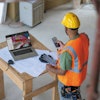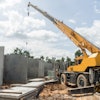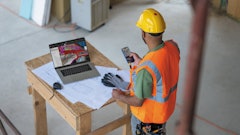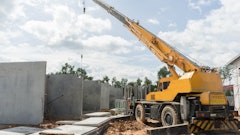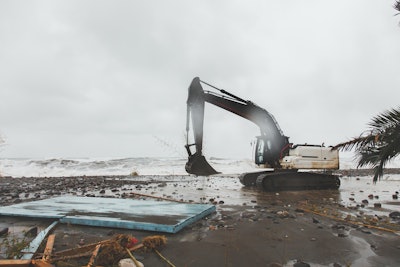
In the first decade that FEMA (the Federal Emergency Management Agency) was established, it recorded 25 major disasters per year, on average. But in the last decade, that number jumped to 63 major disasters recorded annually, which was more than a 150% increase in eighty years.
And yet, the way we respond in the field hasn’t kept pace. Too often, crews are still working from outdated processes and fragmented information, with little real-time insight into what’s unfolding on the ground. It results in longer site recovery times, higher costs and greater risks to public safety.
Hurricane recovery — and emergency response, more broadly — shouldn’t hinge on workflows designed for a different era. What’s needed is a modern framework that scales with crisis and adapts in real time. By transforming field operations through data and AI, we can shift from reactive recovery to proactive resilience.
At its core, that modern framework can be captured in four steps: Survey, Triage, Execute and Inspect.
Survey: Build An Always-On Data Collection Strategy
Every minute counts in a crisis, but precious time is wasted as we struggle to see, understand and act on what’s happening. Field work teams can get those minutes back and better visibility with a real-time data collection strategy.
When a field worker conducts a routine site survey through a digital platform, they’re collecting information about weak points that might fail faster in the next storm. For example, when floodwaters rise, a small breach in a barrier can quickly escalate to catastrophic outages across the grid. Capturing that vulnerability before the storm passes allows crews to anticipate and prepare for storm damage.
Take advantage of what every person carries in their pocket: a smartphone. Turn communities into active surveyors of damage by crowdsourcing their observations.
When ordinary citizens can report a leaning utility pole or scattered debris in the streets, field work teams get early warnings about hazards that threaten both crews and communities, preventing small problems from turning into widespread outages.
The more data is captured, the richer the pool becomes, and the stronger the predictive analytics that fuel proactive, preventative measures. And geolocation makes understanding what asset the data relates to a breeze.
Triage: Know What to Tackle First, and Fast
Not every job carries the same urgency. And in an emergency response, a failure to prioritize can cost teams hours.
A report from Texas A&M’s Bush School of Government & Public Service shows manual damage triage can add two to six hours per incident before crews are even dispatched. That delay can be the difference between a contained outage and cascading failures across a community.
AI-fueled platforms can help prioritize repairs that protect the most people and restore the greatest capacity first. Consider a scenario where crews are responding to flooded neighborhoods post-hurricane. As they clear debris, repair power lines, and restore critical services, dashboards can immediately re-prioritize tasks based on new hazards, escalating risk or shifting weather patterns. A team finishing repairs at one site can be redeployed to the next high-priority location without waiting for manual updates, cutting downtime and improving community resilience.
If multiple substations are damaged after a hurricane, AI can pinpoint the one whose outage might trigger the largest downstream blackout, ensuring field teams move where they can have the greatest impact.
Execute: Work Faster with Fewer Errors
In an emergency response, crews often arrive at unfamiliar sites or assigned tasks outside their usual expertise. “Just-in-time,” AI-based learning modules can equip field workers with instant, location-specific guidance on safety protocols, recent incident data, hazard alerts and step-by-step instructions tailored to the task at hand.
But when it comes to faster execution, we need to reimagine the process completely to deploy the right people to the right activities at the right time. This requires technology that ensures every task, team member, and hazard is visible in real time, creating a command center where leaders gain instant insight into ongoing operations.
Supervisors can monitor multiple crews simultaneously and dynamically reassign resources through dashboards. If one team finishes ahead of schedule and another encounters unexpected obstacles, assignments can be adjusted instantly. Automated checklists, digital sign-offs and integrated task tracking ensure that critical steps aren’t skipped and that every action is documented for accountability and future analysis.
This creates a feedback loop where lessons from past deployments inform future operations, making every response faster, safer and smarter.
Inspect: Confirm Work Is Complete, Safe and Ready
Traditionally, quality assurance (QA) in emergency response requires sending teams back to sites to verify repairs, a process that can take hours, days or weeks.
According to a 2023 U.S. Department of Energy assessment, teams at the Waste Isolation Pilot Plant required a minimum of 1-2 days, usually longer, to verify repairs during emergency exercises. Why? Field teams had to physically revisit each site to confirm and for QA sign-off. During their assessment, they noted that the lack of real-time QA data and communication extended timelines substantially, especially in hazardous events.
Instead, with mobile platforms and AI-powered analytics, field teams can confirm that work is complete, hazards have been mitigated, and infrastructure is fully operational, all without waiting for a separate QA visit. After crews repair a damaged power line, digital checklists and geotagged photos can instantly validate the work. AI can flag any anomalies, like missed connections or structural vulnerabilities, so teams can address them immediately.
This accelerates the commissioning of critical assets while ensuring safety for both crews and the communities they serve. Inspecting in real time generates a rich dataset that informs future deployments and strengthens predictive models with recurring vulnerabilities. Over time, this enables faster recovery and smarter preparation for the next storm.
By integrating AI into field operations, we can transform response from a reactive scramble into a proactive, coordinated effort. Hurricane season happens every year. The only question is how severe the next storm will be and how prepared we’ll be to face it and recover faster.


